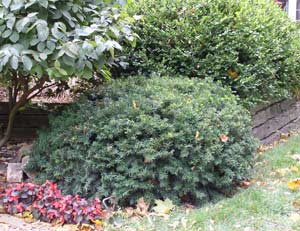Yew – Pruning, Winter Care and Fertilizing
Yew spreading or upright 
These evergreens are normally pruned twice a year, once in early July and again in early September. As much as 2/3 of the new growth can be removed to shape this plant at the July pruning. The fall pruning should be just a light touch up to even out secondary growth.
Groups of plants can be sheared into a tight formal hedge or individually into a particular shape. When sheared in this fashion, the plant should be wider at the base than the top, to help retain lower branches. A less formal look can be achieved by pruning these shrubs with a hand pruners, rather than a hedge shear. Pick pruning will extend the useful life of the plant by giving it a deeper “green” zone. This is done by cutting small holes in the surface of the plant, allowing more light in and new buds to form on the inside of the plant.
This plant grows and develops best in acidic soil. Most of the soil, all of the rainwater and all of the ground water in southeastern Wisconsin is basic or alkaline. Therefore, for some plants to thrive, they need to have special care.
Initially, the soil the plant is installed into should be amended to make it more acidic and to increase the amount of organic matter in the soil. Over time, the soils acidity should be supplemented with an acid-based fertilizer. A liquid fertilizer, Miracid works well. This liquid fertilizer is mixed with water and applied the same as you would water the plant (see product for specific details). This type of fertilization should be done three or four times per year, starting in April and ending by the mid-July. Soil can also be acidified with soil sulfur, aluminum sulfate or cotton seed meal, however, these products will not fertilize the plant. Mulch is also important to acid loving plants. A 2-4″ thickness of bark or needle mulch should surround the plant at least as far out as its drip line.
These evergreens will perform very well through most winters. In severe winters or in open exposures, however, they may discolor, but will bounce back in spring. Winter protection may be needed, however, for the first few years after installation, or if the plant has been under stress. To protect the plant, spray it with an anti-transpirant (such as Wilt-Pruf) in mid to late November. The timing for this application can be somewhat tricky. The temperature must be above 40 degrees, and it cannot rain on the plant after the product has been applied. Watering in late fall is very important for the winter health of any evergreen and should be done to young plants every year in early November. Even more mature plants can benefit from late season waterings, especially after a dry fall season.
